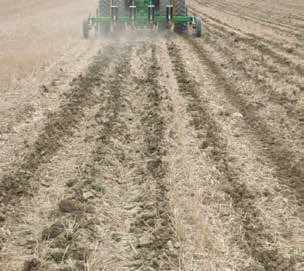chAPter 15 Preventing and lessening CoMPaCtion
In many cases, soil compaction is combined with poor
sanitary practices and lack of rotations, creating a
croPs thAt Are hArd on soILs
dependency on heavy chemical inputs.
Some crops are particularly hard on soils:
• Root and tuber crops like potatoes require intensive
Preventing or Lessening Plow Layer Compaction
tillage and return low rates of residue to the soil.
Preventing or reducing soil compaction generally requires
• Silage corn and soybeans return low rates of residue.
a comprehensive, long-term approach to addressing
• Many vegetable crops require a timely harvest, so
soil health issues and rarely gives immediate results.
field traffic occurs even when the soils are too wet.
Compaction on any particular field may have multiple
Special care is needed to counter the negative effects
causes, and the solutions are often dependent on the soil
of such crops. Counter measures may include selecting
type, climate, and cropping system. Let’s go over some
soil-improving crops to fill out the rotation, extensive
general principles of how to solve these problems.
use of cover crops, using controlled traffic, and adding
Proper use of tillage. Tillage can either cause
extra organic materials such as manures and com-
or lessen problems with soil compaction. Repeated
posts. In an eleven-year experiment in Vermont with
intensive tillage reduces soil aggregation and compacts
continuous corn silage on a clay soil, we found that
the soil over the long term, causes erosion and loss of
applications of dairy manure were critical to maintain-
topsoil, and may bring about the formation of plow
ing good soil structure. Applications of 0, 10, 20, and 30
pans. On the other hand, tillage can relieve compaction
tons (wet weight) of dairy manure per acre each year
by loosening the soil and creating pathways for air and
of the experiment resulted in pore spaces of 44, 45, 47,
water movement and root growth. This relief, however,
and 50% of the soil volume, respectively.
as effective as it may be, is temporary and may need to
be repeated in the following growing seasons if poor soil
in areas that are imperfectly drained. In addition, these
management and traffic patterns are continued.
soils may “hard set” if heavy rains are followed by a dry-
Farmers frequently use more intense tillage to offset
ing period. Crops in their early growth stages are very
the problems of cloddiness associated with compaction
susceptible to these problems (because roots are still
of the plow layer. The solution to these problems is not
shallow), and the plants commonly go through a notice-
necessarily to stop tillage altogether. Compacted soils
able period of stunted growth on compacted soils.
frequently become “addicted” to tillage, and going “cold
Reduced growth caused by compaction affects
turkey” by converting to no-till management may result
the crop’s ability to fight or compete with pathogens,
in failure. Practices that perform some soil loosening
insects, and weeds. These pest problems may become
with minor disturbance at the soil surface may help in
more apparent, therefore, simply because the crop is
the transition from a tilled to an untilled management
weakened. For example, during wet periods dense soils
system. Aerators (figure 15.4) provide some shallow
that are poorly aerated are more susceptible to infesta-
compaction relief in dense surface layers but do minimal
tions of fungal root diseases such as Fusarium, Pythium,
tillage damage and are especially useful when aeration
Rhizoctonia, Thieviopsis and plant-parasitic nematodes
is of concern. They are also used to incorporate manure
such as northern root-knot. These problems can be iden-
with minimal tillage damage. Strip tillage (6 to 8 inches
tified by observing washed roots. Healthy roots are light
deep) employs narrow shanks that disturb the soil only
colored, while diseased roots are black or show lesions.
where future plant rows will be located (figure 15.4). It is
164
Building SoilS for Better CropS: SuStainaBle Soil ManageMent







